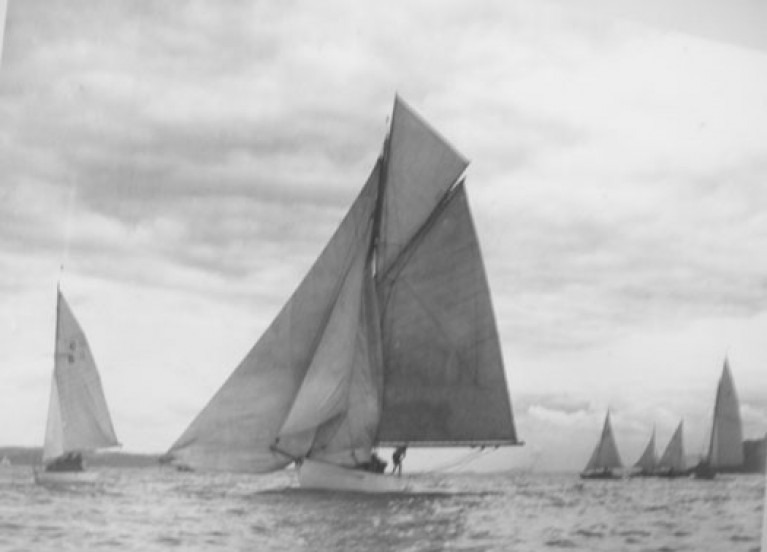Displaying items by tag: Lufra Cup
The History of Belfast Lough's Lufra Cup for the Menagerie Sailing Race
It's 76 years since the Lufra Cup was first presented to the winner of Ballyholme's Menagerie Race, a pursuit event run traditionally to mark Closing Day when there was no such thing as Winter, let alone Autumn racing in Belfast Lough. And that winner was Howard Finlay in his cutter, Lufra, who had himself given the cup to the club in 1944 as the Menagerie Race was trophyless.
 Howard Finlay (second left) and crew on board Lufra 1938 Photo: courtesy Paul Finlay
Howard Finlay (second left) and crew on board Lufra 1938 Photo: courtesy Paul Finlay
This year it was won by Gareth Martel in his Beneteau 40.7 Pippa, in a mixed fleet of 50 keelboats and dinghies. The strong southerly gusting 25 knots didn't bode well for the dinghies but provided exciting sailing, giving at least one, Robin Gray in his Aero, 13. 5 miles with an average speed of 5 knots on his tracker!
 The Lufra Cup today
The Lufra Cup today
The name of the cup derived from the 40ft 12-tonner gaff-rigged cutter Lufra designed by GL Watson in 1894 and built by P R Maclean of Rosneath for T K Laidlaw of Glasgow. Lufra was brought to Northern Ireland in 1937 by Howard Finlay whose descendants are still associated with Ballyholme. He won the 1943 Menagerie Race.
 Lufra in her youth, tearing along on the Clyde in the 1890s Photo: courtesy Iain McAllister
Lufra in her youth, tearing along on the Clyde in the 1890s Photo: courtesy Iain McAllister
Afloat's WM Nixon relates here " but as there was no decent prize available, Howard put up the Lufra Cup for the 1944 race which he won. But some Bay Class types weren't quite so chuffed and suggested that as Howard Finlay had presented the new cup, the right thing to do would be to hand it on to the boat which finished second. He told them very precisely what they could do with that notion".
During the 50s Lufra became expensive to run and unsellable, and as the keel was worth more than the boat itself, this was sold and the boat left to rot and sink in the Quarry Hole harbour in Donaghadee, from where it was sadly dumped when the new marina was built there in the 60s.
 Gareth Martel's First 40.7 Pippa Photo: courtesy Yachting Images
Gareth Martel's First 40.7 Pippa Photo: courtesy Yachting Images
Gareth Martel's Pippa couldn't be more different from Lufra and he joins the long list of winners which includes boats as diverse as a Hurricane, a 505, a Laser and last year's winner, an RS Elite. But one winning boat which was similar to Lufra, in age anyway, was the two berth 5 tonne 25 ft gaff cutter, Marie, built-in 1893 in Howth, reputedly designed by a Miss EW Doyle of the builder's family.
Marie won the Lufra Cup in 1961 with Martin Imrie and his son, also Martin, on board. Unlike Lufra and despite being washed ashore in an early 1960s gale, she was saved and restored but is laid up today.
 Marie (built 1893) pictured circa 1960
Marie (built 1893) pictured circa 1960
- Built: 1893, Howth, of yellow pine on oak. Designed by a Miss EW Doyle of Howth, I think, of the builder's family.
- Rig: Gaff Cutter. Tonnage: 5 T.M. Length overall: 25 feet 7 inches.
- Beam: 7 feet 1 inch. Length on waterline: 24 feet. Draft: 4 feet 6 inches.
- Sail area: 360/420 square feet. Engine: none. Berths: two.
She was wrecked sometime between 1962 and 1965, I think, when she broke her moorings (or was she just anchored?) in the usual early Autumn NE gale, around the time of that year's Menagerie race. We salvaged her from the beach on the next tide and got her into the shipyard. She was then sold to Mike McKee, who had her refastened and she is still sailing somewhere.
























































